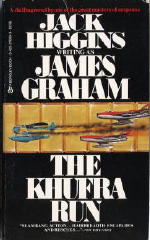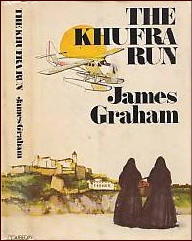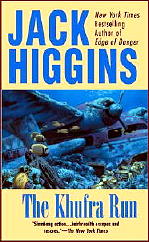Sat 14 Nov 2015
Archived Review: JACK HIGGINS writing as JAMES GRAHAM – The Khufra Run.
Posted by Steve under Reviews[5] Comments
JACK HIGGINS writing as JAMES GRAHAM – The Khufra Run. Berkley, paperback reprint, February 1985. British hardcover edition: Macmillan, 1972. US hardcover edition: Doubleday & Co, 1973. Other paperback editions include: Fawcett Crest, 1976; Pocket Books, 1990; Berkley, 2002.

Here’s something that’s interesting, and maybe you know this already, but of the two authors’ names on the cover of the 1985 paperback I just read, neither is the author’s real one. “Jack Higgins,” still writing today, was born in 1929 as Harry Patterson, and his first several books were published under that byline.
Other names he also went under are: Martin Fallon, Hugh Marlowe and Henry Patterson, but over the years most of his work has been reprinted as by Higgins, the name he’s most known by. (I haven’t checking into that statement, but those that haven’t, if any, would therefore have to be the ones he’s least happy with, looking back at them today.
No matter. It was The Eagle Has Landed, the 1975 thriller about a German attempt to infiltrate England in World War II and capture Winston Churchill, that made Higgins a multi-millionaire. The Khufra Run isn’t in that league, by any means, but it’s hugely entertaining, and if done with a decent B-level budget, it would make a really decent B-grade action movie.
Here’s the opening paragraph:

Here are the last two paragraphs from Chapter One:
A second later, a naked girl ran out of the darkness into the headlights of the jeep.
It is the girl who is the key figure in the rest of the story, which involves a flight Jack Nelson, who tells the story, intends to make from Cartagena to Ibiza (an island off the Spanish coast), a trip for which he most definitely has an ulterior motive.

By profession, Nelson is an island-hopping pilot and small time smuggler. The naked girl is Claire Bouvier, or as it happens, Sister Claire, of the Little Sisters of Pity, on leave from a convent near Grenoble. And as it eventually transpires, she has a proposition for Jack.
Somewhere in the Khufra Marshes off the Algerian coast is a fortune in silver, and Claire, one of the most naive and single-minded women you will ever meet, in fiction or not, needs Jack and his friend Turk to help her find it. On page 20, she tells Jack that “you are a good man in spite of yourself.†Jack is not so sure, nor is the reader, except for the reader who knows exactly how predictable such adventurers (and their adventures) are.
It’s still a rattling good story, whatever that means, even if Jack is rather careless about the bad guys on their trail, and yes, or course there are, and if I didn’t mention them, you should have known without my telling you. Once they all start making their way through the marshes, a very picturesque narrative suddenly goes into overdrive. If you can put the book down after page 138, you are a better man (or woman) than I.
The ending is even better. I like the idea of Audrey Hepburn in the role of Claire, while any tall, slim, grizzled tough guy actor could be Jack. But Audrey Hepburn. She may have been a little slim for the part, but other than that, nothing but net.
November 14th, 2015 at 9:32 pm
The middle-period Higgins books are my favorites. Great stuff.
November 14th, 2015 at 10:01 pm
I’d have to agree. I haven’t read many of his very earliest ones — his first book was in 1959 — so I can’t comment there, but once he hit his stride, he was great. Here’s my review of a fairly recent one, though, one which I felt badly saying some not very complimentary things about:
https://mysteryfile.com/blog/?p=3799
JACK HIGGINS – The Killing Ground (2008).
November 15th, 2015 at 12:30 am
A thought has just occurred to me. Jack Higgins’ latest book is RAIN ON THE DEAD (2014) which means the paperback edition came out sometime this year. If he was born in 1929, that makes him 86. With the passing of P. D. James at 94, how might he stand now in a list of oldest still active mystery writers?
November 15th, 2015 at 6:20 pm
Pre EAGLE Higgins is my favorite, his book THE WRATH OF GOD (filmed with Robert Mitchum). I prefer his early work when he was in the mode of MacLean and Canning.
November 16th, 2015 at 9:01 am
His middle work is also my favorite; starting with EAST OF DESOLATION through THE EAGLE HAS LANDED.